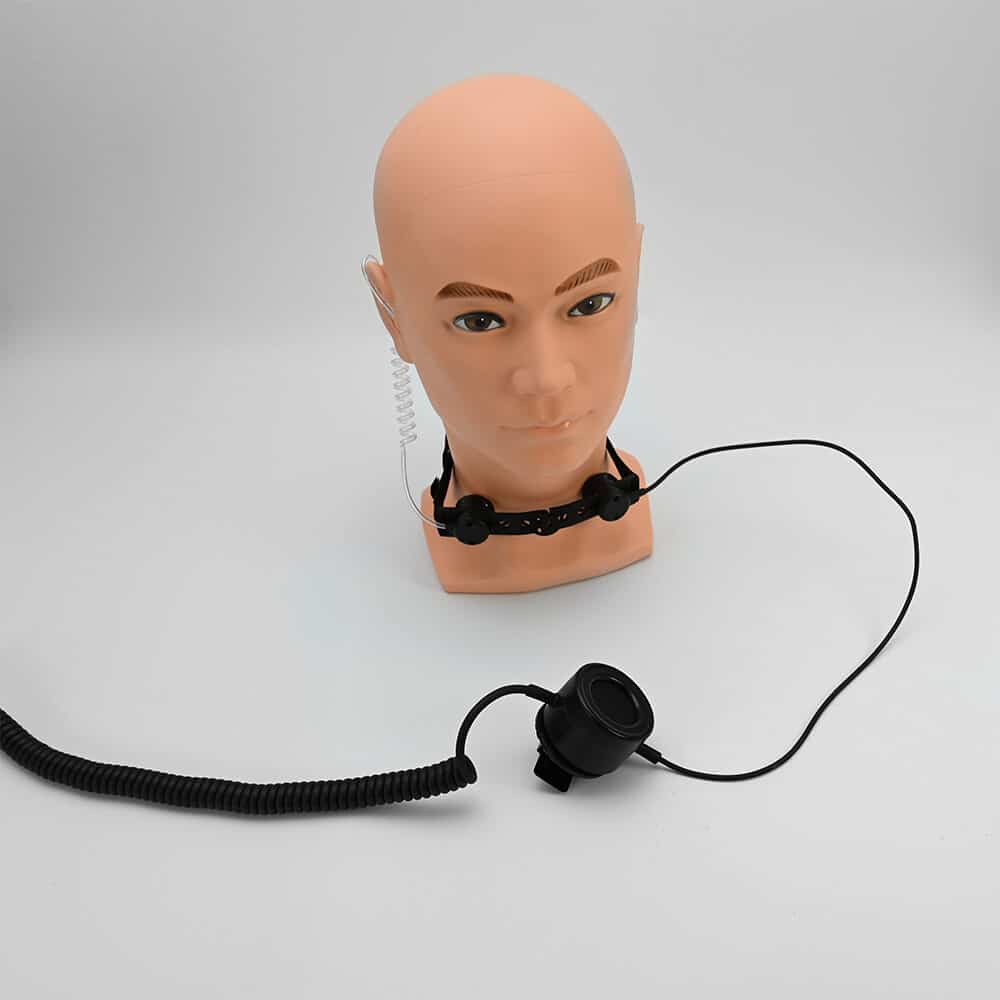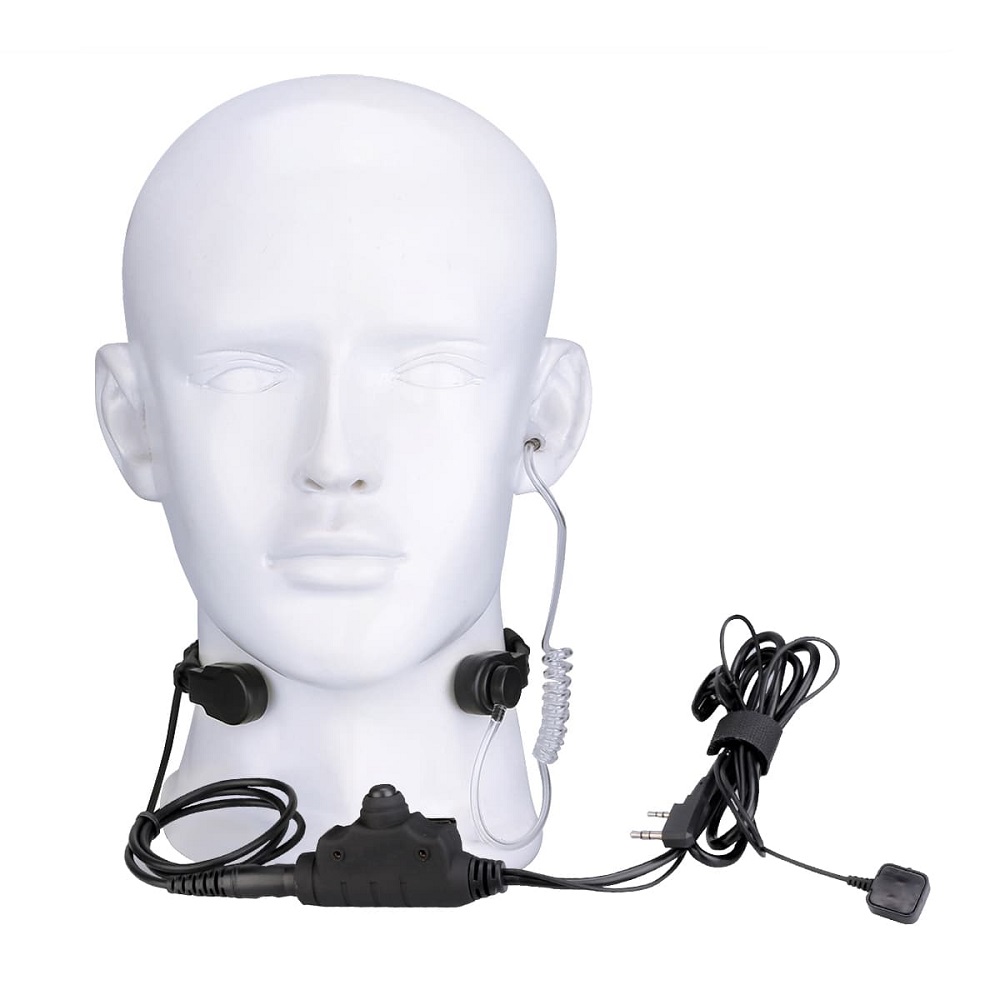Introduction to Throat Microphones
Throat microphones, often called throat mics, are integral tools in various fields. These devices capture sound waves generated by vocal cords directly from the throat. They are especially useful in environments with high ambient noise or where there’s a need for hands-free communication. The design of the throat mic allows it to pick up vibrations from the throat, providing clarity even in challenging situations.
Throat microphones are utilized primarily in military, law enforcement, and security settings. They enhance communication in noisy environments, such as battlefields, concerts, or industrial workspaces. However, they are not limited to just these areas. Many different fields, including broadcasting and gaming, have begun to adopt throat mics for their advantages. Their ability to offer clear audio transmission while minimizing background noise makes them highly effective.

How Throat Microphones Work
Throat microphones operate on a very straightforward principle. They detect sound vibrations created when users speak. Instead of picking up sound from the air, a throat mic uses sensors placed on the skin of the user’s throat. These sensors translate the vibrations into electrical signals. Once converted, the signals can be amplified and transmitted through various audio devices.
The construction of throat microphones typically includes a flexible band that fits comfortably around the throat. This band supports the microphone and keeps it in place. A small disc or another type of sensor rests against the skin to capture vibrations accurately. This design ensures the mic remains stable during movement, a crucial feature in fast-paced environments.
The clarity of sound produced by throat microphones largely depends on the quality of the sensors and the positioning on the throat. Adjustments can often be made to optimize sound capture for the user. Having the right fit is essential to ensure clear communication, especially in loud environments where traditional mics would struggle.
Advantages of Using Throat Microphones
Noise Isolation
One of the most significant advantages of throat microphones is their noise isolation. Traditional microphones pick up sounds from all directions. Throat mics, however, focus solely on the vibrations from the throat. This unique feature allows users to communicate clearly without interference from surrounding noise.
In a shooting range, for example, the loud sounds of gunfire can make it difficult to hear spoken commands. A throat mic can enable soldiers to receive instructions without background distractions. This clarity can be crucial for safety and coordination in high-pressure situations.
Hands-Free Operation
Another benefit of throat microphones is their hands-free operation. This feature is especially valuable in environments where users need to perform tasks simultaneously while communicating. For instance, in a medical emergency, a first responder can provide updates while attending to a patient using a throat mic.
Hands-free operation also improves mobility. Users can move freely without being tethered to a standard microphone. This freedom of movement enhances responsiveness and effectiveness, whether in a military, medical, or industrial setting.
Comfort and Ergonomics
Throat microphones are also designed for comfort. They are lightweight and often adjustable, which allows users to wear them for extended periods. Many models come with padding to ensure they do not irritate the skin. Users can adjust the fit to their preference, which enhances the overall experience.
Adjusting the microphone to the appropriate tightness is essential for capturing sound effectively. Too loose, and the mic may not pick up the necessary vibrations; too tight could lead to discomfort. Thus, ergonomics play a significant role in the design and function of throat microphones.
Applications of Throat Microphones
Military and Law Enforcement
Throat microphones find widespread use in military and law enforcement. Soldiers and officers often work in high-noise environments where traditional communication systems fall short. The clear sound and noise-reducing capabilities of throat mics help maintain coordination and ensure mission success.
Field operatives must communicate effectively while navigating difficult environments. Whether in urban settings or quiet countrysides, throat mics allow for seamless communication, vital for operations that require absolute discretion and effectiveness.
Security and Surveillance
In security, throat microphones serve a critical role. Security personnel need reliable tools for communication. Throat mics permit clear dialogue without alerting potential threats. Surveillance teams can share information without drawing attention.
The ability to whisper commands or alerts reduces the chance of detection. Throat microphones enable teams to remain stealthy. By keeping their communications discreet, security personnel can manage situations more effectively.
Broadcasting and Gaming
Throat microphones are also gaining traction in broadcasting and gaming industries. Streamers and broadcasters often seek high-quality audio to engage their audiences. The noise-canceling features of throat mics can significantly enhance sound quality during live streams or recordings.
Gamers, too, appreciate the convenience and clarity of throat mics. In multiplayer gaming, clear communication can be the difference between victory and defeat. This tool allows players to strategize while remaining engaged and active in gameplay.
Healthcare
The healthcare field is another area where throat microphones show promise. Medical professionals must often communicate vital information without overwhelming noise. Throat mics can ensure that instructions and updates are delivered clearly, even within hectic emergency rooms or busy hospitals.
During transport, medical personnel may need to relay patient information while managing equipment. A throat mic can facilitate this task, allowing for fluid communication while maintaining focus on their duties.
Choosing the Right Throat Microphone
Understanding Your Needs
When choosing a throat microphone, it’s essential to assess your specific needs. The applications you intend to use the mic for can influence your decision. For military purposes, durability may be at the forefront. If you are looking for a mic for streaming, sound quality may take precedence.
Evaluating the environment in which you’ll use the mic is equally important. If you expect high levels of background noise, prioritizing noise-canceling features is a must. For quiet settings, other factors like comfort and fit might be more crucial.
Familiarizing Yourself with Brands
Different brands offer throat microphones with various specifications. Familiarizing yourself with the options available will help narrow down your choices. Reading reviews and seeking recommendations from users in your specific field can provide insights into the best products.
Many brands focus on specific applications, so understanding their expertise can guide your decision. Some produce equipment tailored for military applications, while others target broadcasting or healthcare. Identifying which brands suit your needs can streamline the selection process.
Testing and Feedback
Testing is a vital part of selecting a throat microphone. If possible, try out various models before purchasing. Pay attention to how they fit and the sound quality they deliver. Feeling comfortable while using the mic should be a priority.
Gathering feedback from experienced users can also be beneficial. They can provide insights into the mic’s performance in real-world settings. Sharing experiences within a community can guide you toward the best product for your needs.
Setting Up Your Throat Microphone
Positioning the Microphone
Setting up your throat microphone involves ensuring it is positioned correctly. The mic should rest comfortably against the skin of the throat. Adjust the fit to ensure the sensor captures the vibrational sounds effectively.
Finding the right position may take some trial and error. Everyone’s throat has a slightly different shape and size. Experiment with positioning until you achieve the clearest sound. Once properly set up, your throat mic will perform significantly better.
Connecting to Devices
Most throat microphones connect easily to various audio devices. Many models feature a standardized jack that fits into common audio interfaces. Follow the manufacturer’s instructions for the specific connection requirements.
Make sure that the connection is secure to avoid audio dropouts. If using the throat mic with a communication system, ensure that all components are compatible. This preparation can prevent technical issues that may arise during use.
Testing the Setup
Once the microphone is connected and positioned correctly, it is essential to test it. Speak into the mic and listen for any disturbances or dropouts in the audio. If you notice any issues, recheck the connection and positioning.
Testing is especially crucial in professional settings where clear communication is vital. Before an operation, ensure that all team members test their equipment. Regular checks can prevent mishaps during important missions or tasks.
Maintenance and Care for Throat Microphones
Regular Cleaning
Regular cleaning is a fundamental part of maintaining a throat microphone. Skin oils and sweat can accumulate on the device, potentially affecting sound quality. Use a soft cloth or a designated cleaning wipe to keep the mic surface clean.
Pay attention to the areas that come into contact with the skin. Ensure these parts are sanitized to prevent any build-up that could interfere with sound capture. Regular cleaning is essential for longevity and optimal performance.
Storage Practices
Proper storage practices also contribute to the microphone’s lifespan. Avoid exposing throat microphones to excessive heat or moisture. Use protective cases when transporting them to prevent damage.
When not in use, store the mic away from direct sunlight. Long-term exposure can wear down the materials over time. Keeping the microphone in a clean, dry area will ensure it remains functional for years to come.
Professional Servicing
If you encounter issues with your throat microphone, consider professional servicing. Many manufacturers offer repair or servicing options. Taking advantage of these services can extend the life of your microphone.
Regular servicing can also help identify potential problems before they escalate. This proactive approach ensures your throat mic remains reliable and clear for all future communications.
The Future of Throat Microphones
Technological Innovations
The future of throat microphones is bright as technology continues to evolve. Innovations such as enhanced noise cancellation and improved sensor technology may lead to even clearer sound capture. These advancements will likely increase usage in various fields.
As devices become more compact and lightweight, user comfort will also improve. Industries will continue to adopt these tools for new applications, enhancing communication efficiency.
Expanding Applications
As throat microphones gain popularity, their applications are likely to expand. Fields like education, entertainment, and virtual reality may utilize these devices. Clear, hands-free communication can enhance experiences in many areas.
The demand for effective communication tools will continue to rise. Organizations focusing on team efficiency may turn to throat microphones for better collaboration. This trend will push manufacturers to innovate and improve their product offerings.
Conclusion: The Role of Throat Microphones
In conclusion, throat microphones play a crucial role in enhancing communication across various fields. Their ability to provide clear sound in noisy environments is invaluable. The hands-free operation and comfort design further solidify their reputation.
As technology advances, the future looks promising for throat mics. They will likely adapt and evolve, offering even greater capabilities. Understanding their benefits and applications is essential for anyone considering their use.
Choosing the right microphone can significantly impact communication effectiveness. With the right setup, maintenance, and care, throat microphones can prove to be a reliable tool for years to come.


